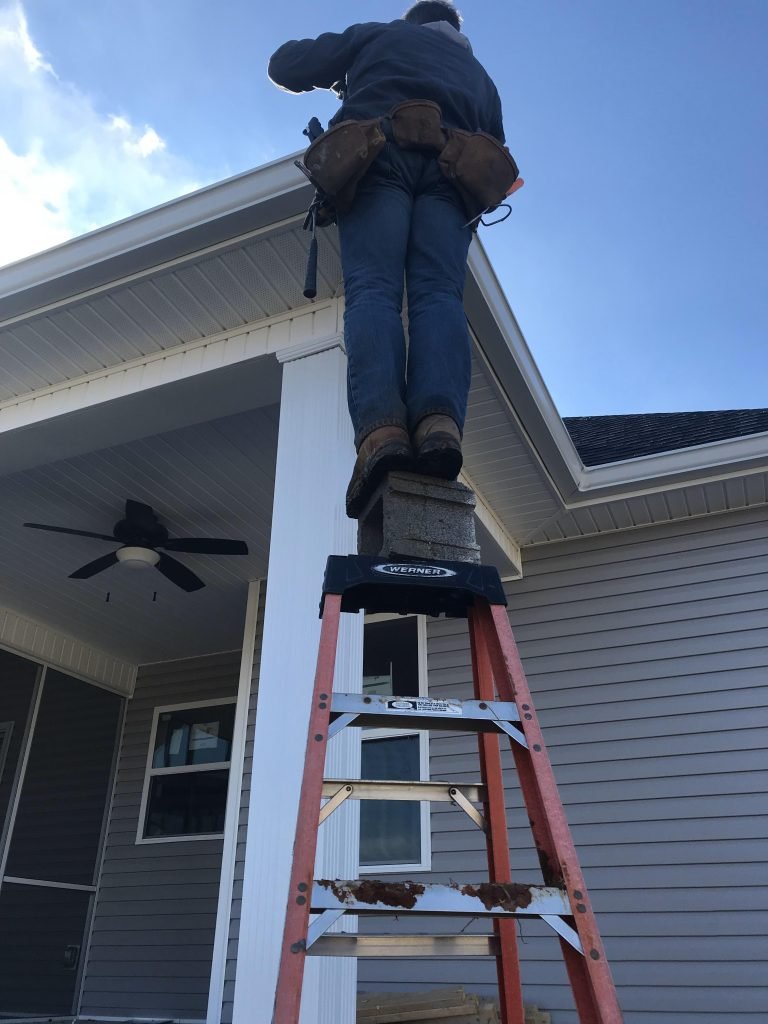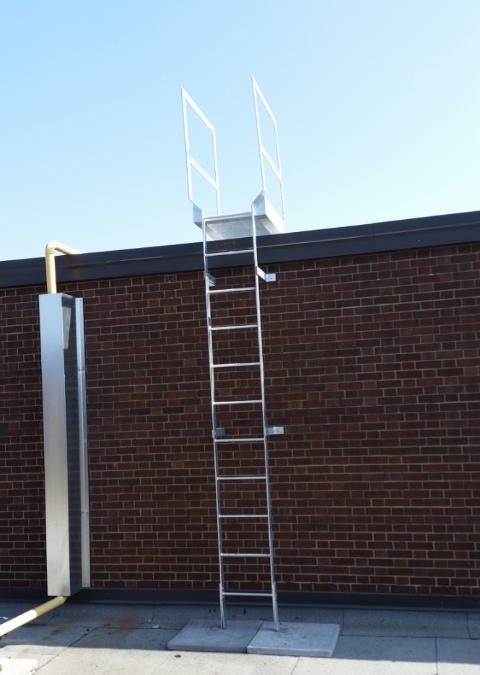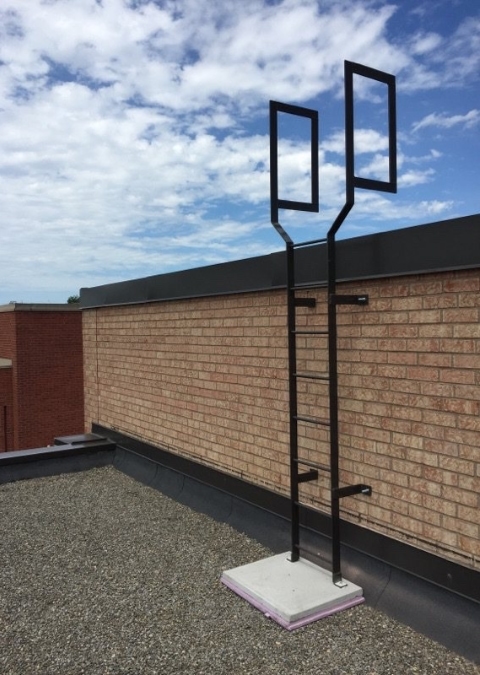
Fixed ladders need proper support to ensure safety and stability. But what exactly are the support requirements?
Fixed ladders are crucial for accessing heights in various industries. Ensuring they meet safety standards is essential. Support requirements for fixed ladders are specific guidelines designed to prevent accidents and injuries. These requirements cover aspects such as ladder strength, mounting, and spacing.
Understanding these guidelines helps in maintaining a safe working environment. In this blog post, we will explore these support requirements in detail. By the end, you’ll know how to keep fixed ladders secure and compliant with safety regulations. So, let’s dive in and learn about the essential support requirements for fixed ladders.

Credit: www.liftsafeinspections.com
Introduction To Fixed Ladders
Fixed ladders are essential in various industries. They provide safe access to elevated areas. Understanding their support requirements is crucial.
Definition And Purpose
Fixed ladders are permanently attached structures. They provide vertical access to different levels. These ladders are often found in industrial settings.
Their main purpose is to ensure safe climbing. Fixed ladders must be sturdy and reliable. They are built to withstand heavy use.
Common Uses
Fixed ladders are used in many places. Here are some common examples:
- Industrial plants: To access machinery and platforms.
- Commercial buildings: To reach rooftops and maintenance areas.
- Warehouses: For accessing storage racks and high shelves.
- Construction sites: To climb scaffolding and elevated workspaces.
These ladders are designed for frequent use. They must meet specific safety standards. Proper installation is key to their effectiveness.

Credit: www.liftsafeinspections.com
Regulatory Standards
Understanding regulatory standards for fixed ladders is crucial for ensuring workplace safety. Compliance with these standards helps prevent accidents and injuries. Let’s dive into the key guidelines and standards you need to follow.
Osha Guidelines
The Occupational Safety and Health Administration (OSHA) sets strict guidelines for fixed ladders. These guidelines are designed to ensure the safety of workers.
- Fixed ladders over 24 feet must have a fall protection system.
- Ladders must be capable of supporting at least two loads of 250 pounds each.
- The distance between rungs must be uniform and between 10 to 14 inches.
- Ladders should be free of sharp edges and splinters.
OSHA also mandates inspections to ensure ladders remain in good condition. Regular maintenance is essential.
Other Relevant Standards
Besides OSHA, other organizations also set standards for fixed ladders. These include:
- ANSI (American National Standards Institute): ANSI standards focus on the design and performance of fixed ladders. They emphasize the importance of ladder strength and durability.
- NFPA (National Fire Protection Association): NFPA standards address emergency access and egress. Fixed ladders in emergency situations must meet specific criteria.
- IBC (International Building Code): IBC standards cover the installation and use of fixed ladders in buildings. They ensure ladders are safe and accessible.
Compliance with these standards ensures a safer working environment. Always check the latest regulations for any updates.
| Standard | Focus Area |
|---|---|
| OSHA | Safety and fall protection |
| ANSI | Design and performance |
| NFPA | Emergency access |
| IBC | Installation and use |
Following these standards is not just about compliance. It is about protecting lives and maintaining a safe work environment.
Design And Construction
Understanding the design and construction of fixed ladders ensures safety and compliance. Fixed ladders must meet specific standards to prevent accidents. This section covers the key aspects of design and construction for fixed ladders.
Material Requirements
Fixed ladders should be made from durable materials. Common materials include:
- Steel – Known for its strength and longevity.
- Aluminum – Lightweight and resistant to corrosion.
- Fiberglass – Non-conductive and ideal for electrical environments.
Each material has its own benefits. Choosing the right material depends on the ladder’s environment and use.
Structural Integrity
The structural integrity of a fixed ladder is crucial. It must support the weight of users and any additional load. Key factors include:
- Load Capacity – The ladder must support at least 200 pounds.
- Rung Spacing – Rungs should be spaced 12 inches apart.
- Anchor Points – Secure anchor points are essential for stability.
Regular inspections ensure the ladder remains safe and functional. Any damage or wear should be addressed immediately.
Safety Features
Ensuring the safety of fixed ladders is crucial. Proper safety features not only prevent accidents but also ensure the longevity of the ladder. In this section, we will discuss the essential safety features that every fixed ladder should have.
Fall Protection
Fall protection is a critical safety feature. Fixed ladders should have a cage or a well that encloses the user. This enclosure helps prevent falls from significant heights. For ladders over 24 feet, adding a personal fall arrest system is recommended. This system includes a harness and a lanyard. Together, they catch the user in case of a fall.
Anti-slip Measures
Anti-slip measures are equally important. Ladders should have rungs with anti-slip surfaces. These surfaces can be serrated or have a special coating. The goal is to prevent slips, especially in wet or oily conditions. Additionally, installing handrails on both sides of the ladder can provide extra support and stability.
Below is a summary of key safety features for fixed ladders:
| Feature | Description |
|---|---|
| Fall Protection | Cage or well, personal fall arrest system |
| Anti-Slip Measures | Anti-slip rungs, handrails |
By implementing these safety features, you can ensure a safer climbing experience for everyone using the fixed ladder.
Maintenance And Inspection
Fixed ladders play a crucial role in ensuring safety and accessibility in various environments. Regular maintenance and inspection of these ladders are essential. This ensures they remain safe and functional. Below, we discuss key aspects of maintaining and inspecting fixed ladders.
Routine Checks
Routine checks are vital for ladder safety. They help identify potential issues before they become serious problems. Conduct these checks weekly, monthly, and yearly.
| Frequency | Checkpoints |
|---|---|
| Weekly |
|
| Monthly |
|
| Yearly |
|
Repair Protocols
Repairs are crucial for ladder longevity and safety. Follow a strict protocol to ensure all repairs are effective and safe.
- Identify the issue: Locate the exact problem area.
- Assess the damage: Determine the extent of the damage.
- Plan the repair: Decide on the best method for fixing the issue.
- Execute the repair: Use appropriate tools and materials.
- Inspect post-repair: Ensure the ladder is safe and functional.
Regular maintenance and inspection not only ensure safety but also extend the lifespan of fixed ladders. Adhering to these practices helps prevent accidents and costly repairs.

Credit: www.designcomponents.com
Training And Certification
Proper training and certification are essential for the safe use of fixed ladders. Employees must understand the risks and procedures. This ensures safety and compliance with regulations. Let’s dive into the specific requirements for training programs and certification.
Training Programs
Training programs for fixed ladder use should cover several key areas. First, they must include safety protocols. These protocols teach how to avoid accidents and injuries. Second, they should address proper climbing techniques. This ensures that users can ascend and descend safely. Third, emergency procedures must be part of the training. Workers need to know what to do if something goes wrong.
- Safety protocols
- Proper climbing techniques
- Emergency procedures
Training should be both theoretical and practical. Classroom sessions help understand the rules and guidelines. Hands-on training allows workers to practice using the ladders. This combination ensures thorough understanding and competence.
Certification Requirements
Certification verifies that an individual is qualified to use fixed ladders. To earn certification, several steps must be completed.
- Complete an approved training program.
- Pass a written exam covering safety rules and procedures.
- Demonstrate practical skills in a supervised setting.
Certifications are typically issued by recognized safety organizations. These organizations ensure that all training standards are met. Certification must be renewed periodically. This ensures that workers stay up-to-date with the latest safety practices.
Below is a table summarizing the key certification requirements:
| Requirement | Description |
|---|---|
| Approved Training | Complete a recognized training program |
| Written Exam | Pass a test on safety rules and procedures |
| Practical Demonstration | Show skills in a supervised environment |
| Certification Renewal | Periodic renewal to stay current |
Meeting these certification requirements ensures that only qualified individuals use fixed ladders. This reduces accidents and improves overall workplace safety.
Frequently Asked Questions
What Materials Are Needed For Fixed Ladder Support?
For fixed ladder support, you need durable materials like steel, aluminum, or fiberglass.
How Do You Install A Fixed Ladder Securely?
Ensure the ladder is anchored to a stable surface, using bolts and brackets for security.
What Is The Required Ladder Spacing?
Ladder rungs should be spaced 12 inches apart to ensure safe climbing.
Are Safety Cages Necessary For Fixed Ladders?
Yes, safety cages are necessary for ladders over 20 feet to prevent falls.
What Are The Maintenance Requirements For Fixed Ladders?
Regularly inspect for rust, wear, and loose bolts. Clean to prevent slip hazards.
Conclusion
Ensuring proper support for fixed ladders is crucial. It enhances safety and compliance. Always follow guidelines for installation and maintenance. Regular inspections help identify potential issues early. Proper support prevents accidents and extends ladder lifespan. Prioritize safety and stay informed about regulations.
This simple approach keeps your workplace secure. Thank you for reading our guide on fixed ladder support requirements.
Recent Posts
Maintaining clean gutters is essential for preventing water damage to your home, and choosing the best ladder for cleaning gutters can make the job much easier and safer. With so many options on the...
Best Ladder for Cleaning Caravan Roof: Top Picks for You Every Adventure!
Today we will discuss the best ladder for cleaning caravan roof. Cleaning caravan roofs is one of the crucial tasks.After many days, a caravan roof can get dirty by debris, dirt, and grime. These can...
